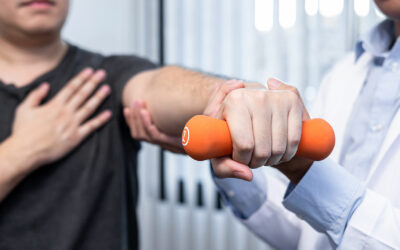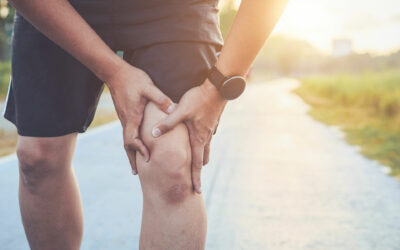It can happen playing sports, working out, or just walking down the street. Everyone has been injured at some point- the human body is a complex organism that is prone to the bumps and bruises of everyday life.
But what are the steps you need to take to get healthy again? If you feel like your injury is not improving, a physical therapist can be a great option to help you recover.
Here are 10 steps to injury recovery.
1. CRITICAL ORIGINAL INJURY STAGE
When your injury first takes place, your initial response can have a drastic impact on your overall recovery outlook. For any injury that does not require an instant visit to the emergency room, there will always be a period of time before you meet and strategize with a physical therapist or doctor.
That means that you have to be extremely cautious right after the injury occurs. It can be easy to worsen your condition, even with common daily tasks. When you are first injured, something as simple as turning a steering wheel or walking up stairs could further strain a shoulder or leg injury.
2. REST AND ICE
After assessing your injury, the very first step is to take it easy and rest the affected area for at least a few days. The resting stage can perfectly coincide with the period of time that you set up an appointment with a physical therapist.
If you’re ever unsure of whether your injury is serious and needs treatment, you should rest a few days nonetheless to be safe. Another cliché that is actually true, icing an injury is always a good idea. If you don’t have ice, try a frozen bag of food from the freezer.
3. COMPRESSION, ELEVATION
The second half of the fail-safe RICE method involves compression and elevation. Like step number 2, you should compress and elevate the injury the same day it occurs, or immediately if possible.
Remember to not wrap the injury too tight when applying compression. If you are applying elevation to the injured area of your body, aim to raise the body part above your heart.
4. LIGHT ACTIVITY/EXERCISING
If you are still at the stage where you are attempting to self-diagnose the severity of your recent injury, this can be a great step to lightly test the affected area. Make sure to never try your regular workout regiment.
Light walks for lower body or the use of very minimal weight for upper body lifts are ideal. Remember, if you ever feel discomfort similar to your original injury, or unusual pain of any type, stop the exercise immediately.
5. EVERY CASE IS DIFFERENT
There are so many factors that vary with each person’s body that could affect injury recovery and progression. Every case is truly different. That’s why you need a physical therapist to help guide you.
The body is too complicated for the average person to understand, and you need guidance to be absolutely sure your injury is healing correctly.
6. BALANCE OF INJURY RECOVERY VS. EXERCISE
This can be one of the trickiest steps to execute within the injury recovery process. It’s important to stay in shape, but not at the expense of your injury recovery. Once you have received a diagnosis from your physical therapist or doctor, you will need to strictly follow their guidance for day-to-day activity.
For some injuries, this may mean no exercise at all for a designated period. Do not ever try to work your way back from an injury through increased exercise.
7. BEWARE OF SETBACKS
Recovering from an injury in many cases can be very difficult. There is potential for setbacks. It can be fairly easy to tweak an injury and worsen your condition. Even if it has begun to improve.
If rehabilitation has stalled, take further measures, and seek more treatment from a doctor. Don’t wait to take action or the condition could worsen.
8. REGAINING STRENGTH
After you have seen a doctor and received further consultation, a physical therapist can still be extremely helpful afterward as well. Again, remember to stay in constant contact with either a doctor or a physical therapist and keep them updated on your condition.
Even when the arrow is pointing up in your recovery and your injury is improving, this is still a critical time where you are more likely to reinjure yourself than when you are completely healthy. Make sure you continue to take it slow in all areas of your life (workouts, or just in general) until you are completely cleared by a doctor.
In general, it is much better to slowly bring yourself back to be completely safe. Unless you are a professional athlete, this is an attainable goal.
9. RETURN TO FULL HEALTH
You made it! There are a few signs to make sure you are completely healed and ready for anything. First off, obviously, you should not be feeling pain from the injury anymore, and swelling should be gone.
Also, make sure you have regained a full range of motion in the injured area.
10. FUTURE INJURY PREVENTION
Now that you have fully recovered from your injury, what’s next? Well, now you can execute a few preventative habits to decrease the chances you are injured in the future.
This is a huge final step after your injury because it can help guide you throughout the rest of your life to avoid deterioration of your body due to injury in the future. How you work out or how you respond to minor nicks and bruises can have a huge impact on your future injury outlook.
Luckily, we have great programs centered solely around injury prevention.
NOW YOU KNOW
Now that you better understand injuries and injury recovery, you know how important it is to take care of your body. Remember that the human body is extremely complex and someone like a physical therapist can be essential to help guide you through injury recovery.
If you are injured, call or contact us today for the best physical therapy practices and start the path to recovery!



